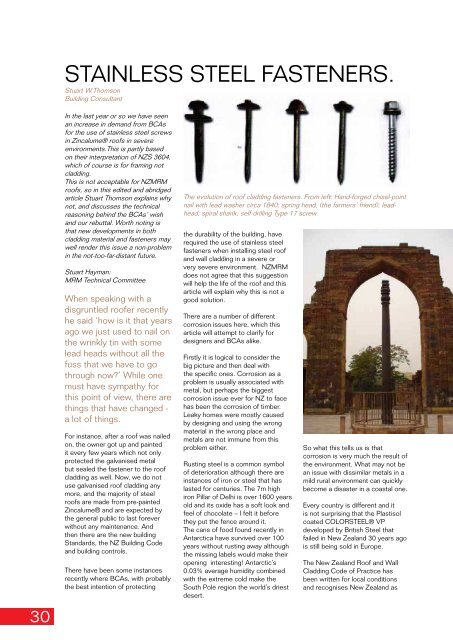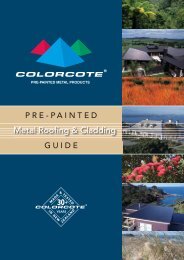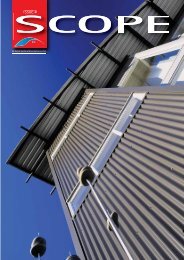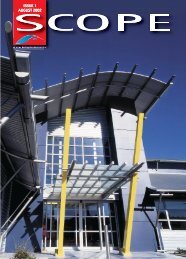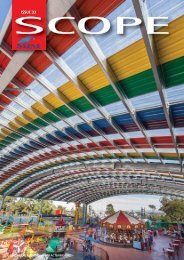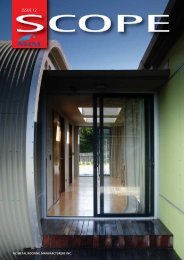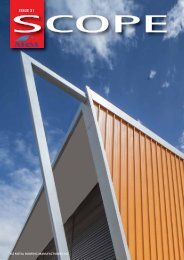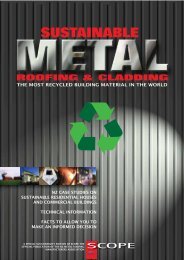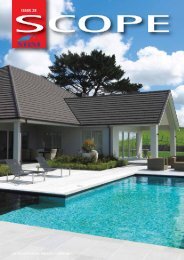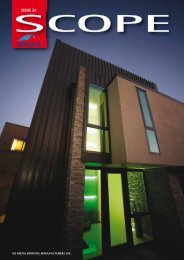ISSUE 27 - Metal Roofing Manufacturers
ISSUE 27 - Metal Roofing Manufacturers
ISSUE 27 - Metal Roofing Manufacturers
Create successful ePaper yourself
Turn your PDF publications into a flip-book with our unique Google optimized e-Paper software.
STAINLESS STEEL FASTENERS.Stuart W.ThomsonBuilding ConsultantIn the last year or so we have seenan increase in demand from BCAsfor the use of stainless steel screwsin Zincalume® roofs in severeenvironments.This is partly basedon their interpretation of NZS 3604,which of course is for framing notcladding.This is not acceptable for NZMRMroofs, so in this edited and abridgedarticle Stuart Thomson explains whynot, and discusses the technicalreasoning behind the BCAs’ wishand our rebuttal. Worth noting isthat new developments in bothcladding material and fasteners maywell render this issue a non-problemin the not-too-far-distant future.Stuart Hayman:MRM Technical CommitteeWhen speaking with adisgruntled roofer recentlyhe said ‘how is it that yearsago we just used to nail onthe wrinkly tin with somelead heads without all thefuss that we have to gothrough now?’ While onemust have sympathy forthis point of view, there arethings that have changed -a lot of things.For instance, after a roof was nailedon, the owner got up and paintedit every few years which not onlyprotected the galvanised metalbut sealed the fastener to the roofcladding as well. Now, we do notuse galvanised roof cladding anymore, and the majority of steelroofs are made from pre-paintedZincalume® and are expected bythe general public to last foreverwithout any maintenance. Andthen there are the new buildingStandards, the NZ Building Codeand building controls.There have been some instancesrecently where BCAs, with probablythe best intention of protectingThe evolution of roof cladding fasteners. From left: Hand-forged chisel-pointnail with lead washer circa 1840; spring head, (the farmers’ friend); leadhead;spiral shank; self-drilling Type 17 screw.the durability of the building, haverequired the use of stainless steelfasteners when installing steel roofand wall cladding in a severe orvery severe environment. NZMRMdoes not agree that this suggestionwill help the life of the roof and thisarticle will explain why this is not agood solution.There are a number of differentcorrosion issues here, which thisarticle will attempt to clarify fordesigners and BCAs alike.Firstly it is logical to consider thebig picture and then deal withthe specific ones. Corrosion as aproblem is usually associated withmetal, but perhaps the biggestcorrosion issue ever for NZ to facehas been the corrosion of timber.Leaky homes were mostly causedby designing and using the wrongmaterial in the wrong place andmetals are not immune from thisproblem either.Rusting steel is a common symbolof deterioration although there areinstances of iron or steel that haslasted for centuries. The 7m highiron Pillar of Delhi is over 1600 yearsold and its oxide has a soft look andfeel of chocolate – I felt it beforethey put the fence around it.The cans of food found recently inAntarctica have survived over 100years without rusting away althoughthe missing labels would make theiropening interesting! Antarctic’s0.03% average humidity combinedwith the extreme cold make theSouth Pole region the world’s driestdesert.So what this tells us is thatcorrosion is very much the result ofthe environment. What may not bean issue with dissimilar metals in amild rural environment can quicklybecome a disaster in a coastal one.Every country is different and itis not surprising that the Plastisolcoated COLORSTEEL® VPdeveloped by British Steel thatfailed in New Zealand 30 years agois still being sold in Europe.The New Zealand Roof and WallCladding Code of Practice hasbeen written for local conditionsand recognises New Zealand asunique islands 2,000 km away fromany other major land mass. NewZealand, being in the middle oflarge oceans, naturally has its coastexposed to high winds, UV and highsalt aerosol. Everyone likes to liveby the sea notwithstanding that thiscreates a very severe corrosionenvironment (C5).For corrosion to occur there mustbe an electrolyte i.e. moisture,and it just so happens that saltis hygroscopic and therefore if itis not washed off the metal thecontact remains wet. The moresalt and the longer the time thecontact remains wet, the worse thecorrosion. All metals have differentelectrochemical potentials andthe greater the difference of thepotential between metals in contact,the worse the corrosion.The subject of corrosion is coveredcomprehensively in section 2.4. ofthe COP.New Zealand has been classifiedinto corrosion categories or zonesby various NZ Standards which haveall used ISO 9223 and ISO 9224 astheir basis. However each new NZor AS/NZ Standards committee forone reason or another has modifiedthese classifications to suit theprime purpose of the standard underreview.These have now been changedto the extent that there is conflictbetween not only the nomenclatureused, but also the essence of theStandard classification. The metalmanufacturers’ paint systems andmetal fasteners are also classifiedfor performance to ISO categoriesso it is little wonder that there isconfusion because we have justabout as many referees on the fieldas we have players.The latest example appears in therevised and recently publishedNZS 3604:2011 but AS/NZS 3566and AS/NZS <strong>27</strong>28 are also recentexamples. The classification of theISO corrosivity of atmospheres isrelatively simple - they are C1 to C5.These are determined by airbornesalinity, the TOW (Time of Wetness)and RH (Relative Humidity)although there are a number ofmethods given to determine these.The decision by the Standardscommittee to introduce a ‘SeaSpray’ Zone into NZS 3604:1999,as well as turning the categorizingnumbers inside out, was a bad moveand opposed by the NZMRM at thetime.NZS 3604: 2011 reverses thatdecision and has now deleted the SeaSpray Zone - just when everyone wasgetting their head around it!. A newnomenclature borrowed from AS/NZS <strong>27</strong>28 has now been substitutedwhich reclassifies C2-C5 intoCategory B to E. (In 3604 CategoryA, indoors has been omitted,and Category D and E have beencombined, because they both use thesame stainless fasteners).This change could continue to createthe occasional demands by BCAs touse stainless steel fasteners for roofcladding in the worst corrosion zone(now become D in 3604); withoutregard for metal compatibility. Thisconfusion occurs because Table4.1 of NZS 3604 2011 requiresall structural fixings in Zone D insheltered and exposed environmentsto be 304 stainless steel.There are anomalies within 3604 andthe NZBC E2 & B2 because if metalroof and wall cladding is consideredeasy to replace, the fastener legallyneed only last 15 years. But trytelling this to an owner who hasrusty fasteners after a few years e.g.Westpac Stadium.There is a different reason for theNZS 3604 emphasis because itis primarily concerned about theintegrity of timber structures and theirconnections. A stainless fastener isrequired to work in treated timberin these instances for a number ofreasons. Firstly the head is in anexposed marine environment andsecondly, the part of the fastener thatis embedded in the timber is likelyto suffer corrosion from the coppersalts required to preserve exposedtimber. Exposed timber also suffersfrom the corrosion of embedded steelfasteners which is known as ‘timbersickness’.For this reason all fixings in contactwith timber treated to H3.2 orhigher or with Copper Azole, orAlkaline Copper Quaternary (ACQ)preservatives, and used in exposedor sheltered locations must be 304stainless steel.30 31


